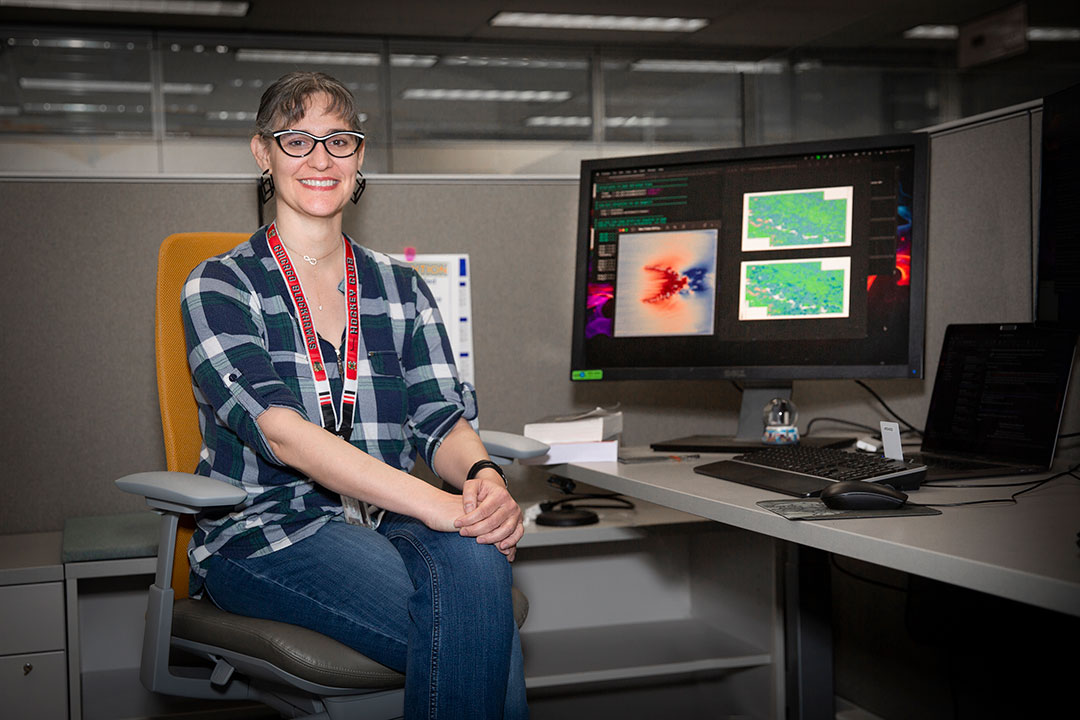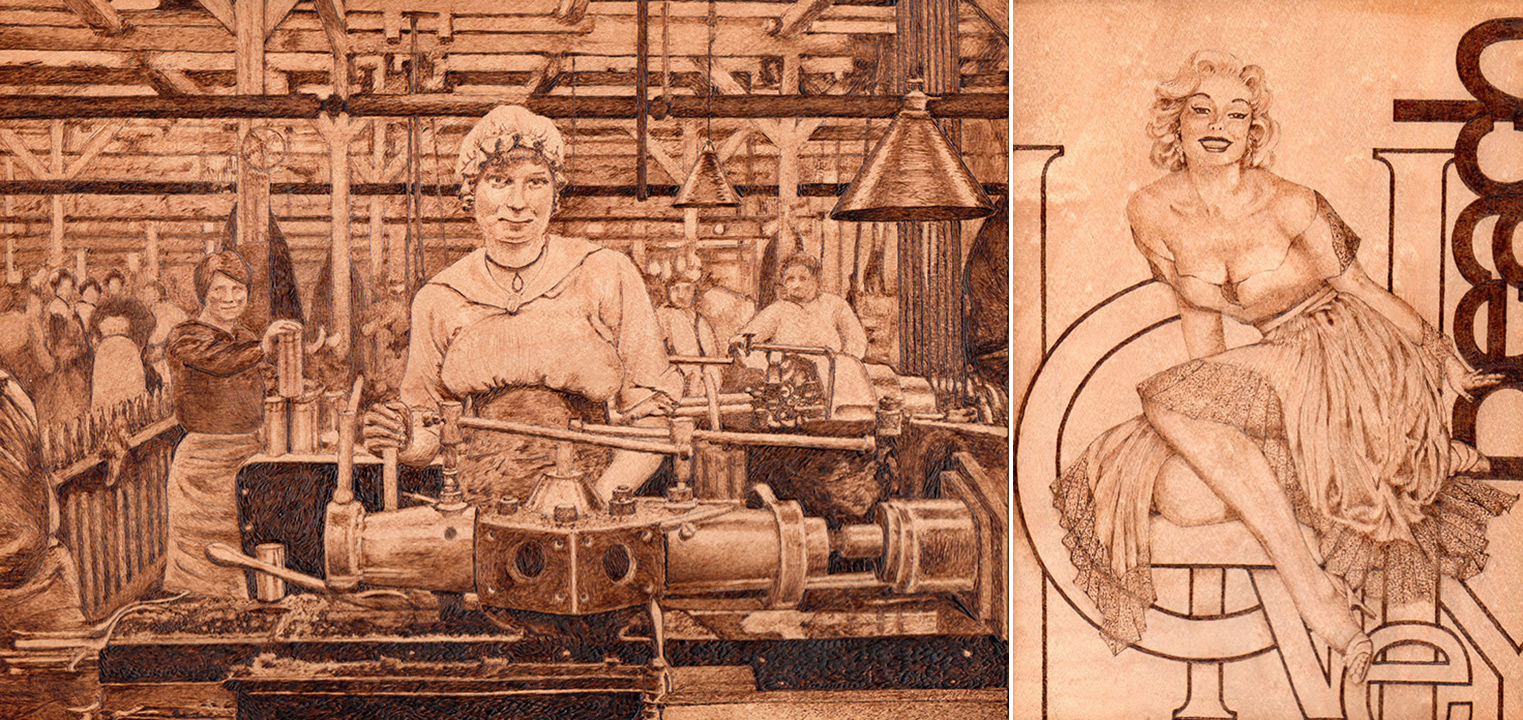Ph.D. student explores fire through visual art and math modeling
Jenna Sjunneson McDanold’s artistic work complements her studies in modeling fire behavior
Los Alamos National Laboratory
Photo taken in Sjunneson McDanold’s cubicle at the Los Alamos National Laboratory for an article written in SIAM News in 2022 on the RIT math modeling Ph.D. program. Sjunneson McDanold’s work has combined her academic and artistic skills.
From fireworks to woodburning to modeling fire behavior, Jenna Sjunneson McDanold’s love of fire has fueled her growth as an artist and a mathematician. As part of her studies as mathematical modeling Ph.D. student with a concentration in dynamical systems and fluid dynamics, Sjunneson McDanold, who is originally from Chicago, has been working at the Los Alamos National Laboratory. Her experience with many artistic media has translated into an aptitude for the creative and visual sides of math.
What has been your experience working at Los Alamos National Lab as part of your Ph.D. program?
I find myself very lucky to have had the opportunity to work at the Los Alamos National Laboratory since September 2020. Starting in the midst of the COVID-19 pandemic had its challenges, but the group that I work with has been very welcoming and encouraging from the start. The lab fully supports its students, so almost everything that I do for the lab doubles as a part of my thesis, allowing me to work full time and also have a healthy work/life balance. The greatest advantage of working at the lab is having access to scientists from a variety of fields like mechanical or chemical engineering, hydrology, ecology, and atmospheric sciences, to name a few. Having these experts to check my understanding and help to edit my papers has been essential to my growth within this career.
Can you describe your path toward your current field of study?
My first job was in fireworks as a technician, a shooter, and eventually designing and helping coordinate shows. As an undergrad, I studied theatrical lighting design at DePaul University in Chicago, which led me to be a scenic painter, mural artist, and carpenter for the first decade after graduation in 2002. Around 2010, I chose to broaden my work by pursuing degrees in mathematics. I got a master’s in mathematical education in 2013, followed by a master’s in pure math in 2015, both from DePaul. During my second master’s degree, I took a class in mathematical modeling that introduced me to this field and helped me realize that I could combine my love of math with my love of fire by modeling fire behavior. I taught undergraduate mathematics in Chicago for a few years as I searched for a Ph.D. degree where I would be able to pursue these interests. In 2017, I came upon the math modeling Ph.D. program at RIT, applied, and was accepted.
What kinds of artistic work do you do, and why is it important to you?
Within my lifetime, I have dabbled in several mediums including paint, carving, carpentry, and metalwork. Currently, I am focused on woodburnings (pyrography) of various subjects. While there is an obvious connection between my work with fire behavior and burning wood as a medium, this choice of medium is also inexpensive, clean, and small-scale, allowing me to do it without requiring a studio or large power tools. Although the pursuit of this degree has temporarily paused my ability to produce burnings at the rate that I used to, being able to continue creating art as a hobby has helped keep me grounded by connecting me to my artistic background and giving me an outlet to do something purely for fun.
Jenna Sjunneson McDanold
Woodburning by Sjunneson McDanold. On the left: Landscape; Recreation of a photo of a woman working during World War I in an arms factory; c.1916 by Jacques Moreau, Archives Larousse, Paris. On the right: Portrait; “Honey Peach” Image expanded from a classic pin-up pose.
My favorite series to date is one in which I pair a pin-up from the ’40s with an image of a woman working within the war efforts. The pin-up also displays names women were often called during that time period – Dame, Honey Peach, Looker, etc. The juxtaposition of the pin-up as the way that women were perceived or viewed at the time, with the image from the war representing what they were actually doing is an interesting representation of feminism.
Although it hasn’t been updated in five years, some of my work can be seen on my website.
How do your academic and artistic pursuits complement each other?
When I was a child, I believed math was black-and-white – right or wrong. The objectivity comforted me in contrast to the subjectivity of writing essays and exploring books. Then, during my pure math master’s degree, studying real analysis opened my eyes to the creativity inherent within this discipline. Math modeling can be interpreted as an artistic medium, using equations to highlight the world around me rather than physical canvas and paint. My personal perspective on the process I am modeling is represented within the equations I choose and the assumptions I make. I now enjoy the freedom that comes with the subjectivity of the modeling, coupled with the objectivity of the analysis that can teach me about fire behavior in new ways.
Visualization is also an important part of mathematical analysis, both for exploring the structure of the system and communicating our results. The fire behavior models we use at the lab produce output that we can string together into videos showing how the fire moves through the given area over time, as well as a variety of parameters that we can visualize using graphs for comparison or testing. I chose my advisor, Dr. Nishant Malik, for his expertise in chaos theory applied to data-driven modeling. With Dr. Malik’s help along with my colleagues from his Complexity Lab, I have gained a better understanding of various advanced mathematical concepts for data analysis including several visualization techniques. The collaboration of Dr. Malik’s influence and my background in art gives me an eye for creating dynamic visualizations that communicate our results using color theory and composition. Using these skills, Dr. Malik and I recently published a paper in Physical Review E which should be available online in the near future.
What is your professional goal after earning your doctoral degree?
Once I finish my doctoral degree, I hope to continue to work on fire behavior modeling and related sciences. While this scientific community is relatively small, there are opportunities for me at the lab, in Europe, and most importantly for me personally, in Australia, where my parents live. For my immediate future, I plan to continue the work on surface fuel mapping and analysis of fire behavior using chaos theory. In the farther future, I plan to expand my experience with some work in atmospheric effects and (hopefully) yet-to-be-discovered patterns of fire behavior.










